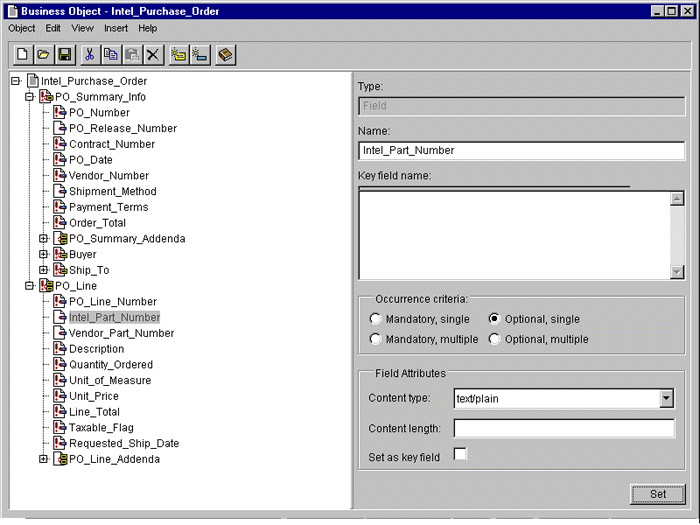 Benefits
of XML Benefits
of XML
 What
is XML? What
is XML?
 How
Does Extricity B2B use XML? How
Does Extricity B2B use XML?
 XML's
Role in Business-to-Business Integration XML's
Role in Business-to-Business Integration
 XML
Links XML
Links
Benefits
of Extricity B2B's XML-enhanced Application:
- Provides secure,
reliable and robust information exchange
- Supports a diverse
variety of information types
- Scalable to support
the diversity of partners, processes and
applications
- Enables flexible
business models
- Lowers cost of
implementation and maintenance
- Supports industry
standard efforts for content definition and
application integration
The eXtensible Markup
Language (XML) is rapidly becoming the de-facto
information standard for a wide variety of software
applications. Why is there so much interest in XML?
What promise does it hold for improving
business-to-business collaboration? These questions
can be answered, in part, by examining the Extricity
Alliance Managerô. The Alliance Managerô provides
a clear example of how XML can be utilized to improve
collaboration among business partners for a variety of
purposes including:
- Collaborative
engineering
- New product
introduction
- Collaborative
planning and forecasting
- Vendor-managed
inventory (VMI)
- Channel assembly
Extricity Alliance
Managerô uses XML as a key underlying technology and
exploits many of its capabilities to deliver
significant business benefits.
What is XML and why
is it important?
XML is a subset of the
Standard Generalized Markup Language (SGML), the ISO
standard for defining descriptions of the structure
and content of different types of electronic
documents. XML provides application designers a
convenient means of representing richly structured
information -- independent of how that information may
be used (e.g. presentation, search, query, data
exchange or other processing).
One factor that has
fueled the excitement in XML is the wide variety of
available tools and applications that either support
it today or plan support for it in the future. Key
examples include native support for XML in the current
releases of the leading Web browsers as well as
announced support from several of the leading ERP
vendors. Because of its flexibility, XML is destined
to become an essential building block to a large
number of software products.
How does Extricity
Alliance Managerô use XML to support
business-to-business integration?
Extricity offers a
breakthrough solution for business-to-business
integration that makes extensive use of XML standards
and technology. Extricity B2B enables partners in the
extended enterprise to collaborate through shared
automated processes. These processes manage the
exchange of information among partners and the
interactions with business applications at each
partner site. In Extricity B2B, processes and the
information types used in the processes (called business
objectsin Alliance) use XML Document Type
Definitions (DTDs) as their underlying representation.
Extended enterprise
partners need to share an extremely diverse variety of
information types such as orders, design information,
production plans, forecasts, bills-of-material and
work-in-progress information. Extricity B2B everages
XML to provide flexible support for this diversity
with key capabilities that include graphical tools to
edit and view business objects and their definitions,
script-based runtime access to business object
contents, and transformation and communication of the
business objects.
Advances in XML
standards and technology will continue to provide
benefits to Extricity B2B users. Increasingly,
industry standards bodies are creating content
definitions based on XML (e.g. VICS CPFR, OAG's OAGIS,
and RosettaNet) that can be exploited in Extricity
B2B. Advances in style sheet, query and validation
rules and capabilities associated with XML will
benefit applications like Extricity B2B that adopt XML
formalisms. In addition, Extricity B2B can take
advantage of the increasing number of XML-based
interfaces that applications are providing to reduce
the effort expended on application integration.

Extricity B2B provides
a graphical user interface to define XML-based
business objects.
XML's Role in
Business-to-Business Integration
XML plays at least two
very important roles in addressing the needs of
business-to-business integration. First, it provides a
rich and flexible set of building blocks that enable
software developers to build better solutions with
less effort. This would include application-based
business-to-business solutions like Extricity B2B, as
well as custom solutions built by systems integrators
or others.
A second important role
for XML is as a common language for the representation
of industry content standards. Content repositories
based on XML are becoming available in many places.
Work is also underway to examine the conversion of
existing standards such as the ANSI X12 transaction
sets to an XML representation. Content standards are a
means of settling semantic differences among business
partners and an important compliment to the
technologies that process the information. XML makes
it easier to define and use content libraries and
commonality in syntax and structure across different
organizations.
Like all building block
languages or standards, the real use and power of XML
is in delivering it to businesses in the form of a
useful application solution. Although XML will
be an increasingly common component of solutions that
address business-to-business integration challenges,
it is the entirety of an application, such as
Extricity B2B, that adds to XML the ability to perform
a collection of important tasks. These tasks
include the coordination of various business partners,
the resolution of industry disputes regarding
information content and the like.
XML Links
Further information
on XML is available at:

|

